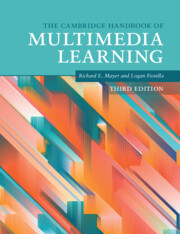Book contents
- The Cambridge Handbook of Multimedia Learning
- The Cambridge Handbook of Multimedia Learning
- Copyright page
- Contents
- Figures
- Tables
- Contributors
- Preface
- Acknowledgments
- Part I Background
- Part II Theoretical Foundations
- 5 Cognitive Theory of Multimedia Learning
- 6 Implications of Cognitive Load Theory for Multimedia Learning
- 7 Integrated Model of Text and Picture Comprehension
- 8 Implications of the Four Component Instructional Design Model for Multimedia Learning
- 9 Motivation and Affect in Multimedia Learning
- 10 Metacognition in Multimedia Learning
- Part III Basic Principles of Multimedia Learning
- Part IV Principles for Reducing Extraneous Processing in Multimedia Learning
- Part V Principles for Managing Essential Processing in Multimedia Learning
- Part VI Principles Based on Social and Affective Features of Multimedia Learning
- Part VII Principles Based on Generative Activity in Multimedia Learning
- Part VIII Multimedia Learning with Media
- Author Index
- Subject Index
- References
6 - Implications of Cognitive Load Theory for Multimedia Learning
from Part II - Theoretical Foundations
Published online by Cambridge University Press: 19 November 2021
- The Cambridge Handbook of Multimedia Learning
- The Cambridge Handbook of Multimedia Learning
- Copyright page
- Contents
- Figures
- Tables
- Contributors
- Preface
- Acknowledgments
- Part I Background
- Part II Theoretical Foundations
- 5 Cognitive Theory of Multimedia Learning
- 6 Implications of Cognitive Load Theory for Multimedia Learning
- 7 Integrated Model of Text and Picture Comprehension
- 8 Implications of the Four Component Instructional Design Model for Multimedia Learning
- 9 Motivation and Affect in Multimedia Learning
- 10 Metacognition in Multimedia Learning
- Part III Basic Principles of Multimedia Learning
- Part IV Principles for Reducing Extraneous Processing in Multimedia Learning
- Part V Principles for Managing Essential Processing in Multimedia Learning
- Part VI Principles Based on Social and Affective Features of Multimedia Learning
- Part VII Principles Based on Generative Activity in Multimedia Learning
- Part VIII Multimedia Learning with Media
- Author Index
- Subject Index
- References
Summary
Human cognitive architecture indicates the manner in which cognitive structures and processes are organized. In turn, that architecture can be used to hypothesize the relative effectiveness of alternative instructional designs. Over several decades, cognitive load theory has simultaneously identified those aspects of human cognition relevant to instructional issues and tested the resultant hypotheses using randomized, controlled experiments. The cognitive architecture used by cognitive load theory has continually been developed and refined over this period. Currently, that architecture is based on evolutionary principles. This chapter outlines the cognitive architecture used by cognitive load theory and provides a general indicator of its relevance to instructional design issues associated with multimedia instruction.
Keywords
Information
- Type
- Chapter
- Information
- The Cambridge Handbook of Multimedia Learning , pp. 73 - 81Publisher: Cambridge University PressPrint publication year: 2021
References
Accessibility standard: Unknown
Why this information is here
This section outlines the accessibility features of this content - including support for screen readers, full keyboard navigation and high-contrast display options. This may not be relevant for you.Accessibility Information
- 15
- Cited by
